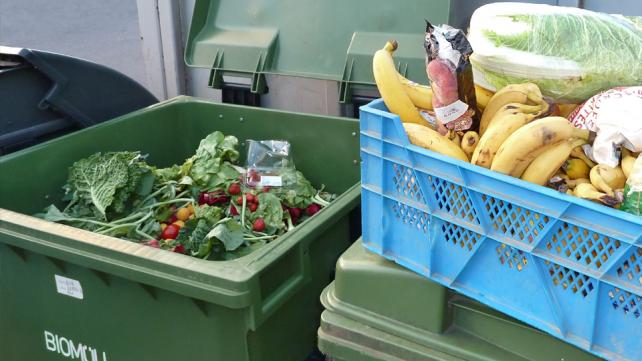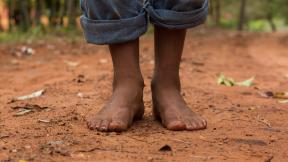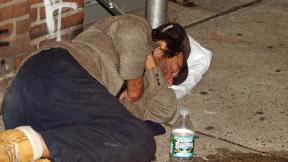
Poverty in America? One of the richest countries in the world?
Yes, poverty is a reality in America, just as it is for millions of other human beings on the planet. According to the US Census Bureau, 35.9 million people live below the poverty line in America, including 12.9 million children.
This is despite abundance of food resources. Almost 100 billion pounds of food is wasted in America each year. 700 million hungry human beings in different parts of the world would have gladly accepted this food.
Here are some statistics on the nature of poverty and the waste of food and money in America.
-In 2004, requests for emergency food assistance increased by an average of 14 percent during the year, according to a 27-city study by the United States Conference of Mayors.
-Also in this study, it was noted that on average, 20 percent of requests for emergency food assistance have gone unmet in 2004.
-According to the Bread for the World Institute 3.5 percent of U.S. households experience hunger. Some people in these households frequently skip meals or eat too little, sometimes going without food for a whole day. 9.6 million people, including 3 million children, live in these homes.
-America's Second Harvest (http://www.secondharvest.org/), the nation's largest network of food banks, reports that 23.3 million people turned to the agencies they serve in 2001, an increase of over 2 million since 1997. Forty percent were from working families.
33 million Americans continue to live in households that did not have an adequate supply of food. Nearly one-third of these households contain adults or children who went hungry at some point in 2000.
U.S. Dept. of Agriculture, March 2002, "Household Food Security in the United States, 2000"
Wasted food in America
-According to America’s Second Harvest, over 41 billion pounds of food have been wasted this year.
-According to a 2004 study from the University of Arizona (UA) in Tucson, on average, American households waste 14 percent of their food purchases.
Fifteen percent of that includes products still within their expiration date but never opened. Timothy Jones, an anthropologist at the UA Bureau of Applied Research in Anthropology who led the study, estimates an average family of four currently tosses out $590 per year, just in meat, fruits, vegetables and grain products.
Nationwide, Jones says, household food waste alone adds up to $43 billion, making it a serious economic problem.
- Official surveys indicate that every year more than 350 billion pounds of edible food is available for human consumption in the United States. Of that total, nearly 100 billion pounds - including fresh vegetables, fruits, milk, and grain products - are lost to waste by retailers, restaurants, and consumers.
-“U.S.-Massive Food Waste & Hunger Side by Side” by Haider Rizvi
-According to a 1997 study by US Department of Agriculture's Economic Research Service (ERS) entitled "Estimating and Addressing America's Food Losses", about 96 billion pounds of food, or more than a quarter of the 356 billion pounds of edible food available for human consumption in the United States, was lost to human use by food retailers, consumers, and foodservice establishments in 1995.
Fresh fruits and vegetables, fluid milk, grain products, and sweeteners (mostly sugar and high-fructose corn syrup) accounted for two-thirds of the losses. 16 billion pounds of milk and 14 billion pounds of grain products are also included in this loss.
Food that could have gone to millions
According to the US Department of Agriculture, up to one-fifth of America's food goes to waste each year, with an estimated 130 pounds of food per person ending up in landfills. The annual value of this lost food is estimated at around $31 billion But the real story is that roughly 49 million people could have been fed by those lost resources. (For your persona jihad against wastage, see A Citizen's Guide to Food Recovery
(The figures below are 1998 figures)
- Proportion of Americans living below the poverty level: 12.7 percent (34.5 million people)
- The average poverty threshold for a family of four: $16,660 in annual income
- The average poverty threshold for a family ofthree: $13,003 in annual income
- Poverty rate for metropolitan areas: 12.3 percent
- Poverty rate forthose living inside central cities: 18.5 percent
- Poverty rate for those living in the suburbs: 8.7 percent
- Percentage and number of poor children: 18.9 percent (13.5 million)
- Children make up 39 percent of the poor and 26 percent of the total population.
- The poverty rate for children is higher than for any other age group.
Child poverty:
- -for children under age 6 living in families with a female householder and no husband present: 54.8 percent
- -for children under age 6 in married-couple families: 10.1 percent
- Poverty rate for African Americans: 26.1 percent
- Poverty rate for Asians and Pacific Islanders: 12.5 percent
- Poverty rate for Hispanics of any race: 25.6 percent
- Poverty rate fornon-Hispanic whites: 8.2 percent
Photo Attribution: http://commons.wikimedia.org/wiki/File:Recovering_wasted_food.JPG








Comments
Don't forget that the poverty rate in America is almost the same as any other industrial country. I'm Swedish, and Finland for example has just as a high poverty rate as the US, they also have a much smaller population and higher Gross Product per Capita.And the bar of being poor in America is much higher than other industrial countries too. Hypothetically if Sweden was an American state, around 40% of our population would be considered to be in poverty.
Location
Hi I'm from sweden and i am doing a work on poverty in america! good facts!!
Location
Poverty is a huge issue in America although very few realize it. We should all lend a hand to someone in need. They will appreciate it more than we' ll ever know.
Location
Oh my god you are a lifesaver because you gave me awesome info on poverty and it's just really great that i found this site! because if i hadn't found info on poverty i would fail my speech class!thank you so much!
Location
I'm in 8th grade and I found a lot of *GREAT* info for my speech that I'm writing for Language Arts. It's really sad that all that was said is true and it's great that your putting it out there for everyone to find on their time! Thanks!!!!!!!!!!!
Location
We are also forgetting the effects poverty has on our children. They go to school hungry so they are not getting a good education, our schools are inadequate and do not intercede to help. Therefore they grow up uneducated,they learn poverty and so the cycle continues.
Location
Good website. I'd like to ask you to see my websites which explain (what I think) is the cause of world poverty. It's called "Employees are slaves & so are masters."http://www.geocities.com/sundiii
Location
This site is very imformative, but where are the references? It seems to me that without references there is no validity in any of the information and thus there is no truth. I know there is a serious problem with poverty in the U.S. , but to ensure the intelligence and understanding level of its' citizens one must put forth some sort of proof for it's evidence in its' inference.
Location
America is a third world country.When I was there on the east coast I was very disapointed with the state of the inner cities.Everywhere I could see urban blight and visable poverty.Shame on you America.Why cant you be more like Australia.In the lucky county,Australia,we have free health care and subsidised education.Everyone in Australia has access to these services.SHAME ON YOU AMERICA.you are nothing but a third world country
Location
The article is very informative... I can't believe that this many kids are hungry everyday. I hope that other people read this article and together we can fight to stop the hunger
Location
Pages
Add new comment